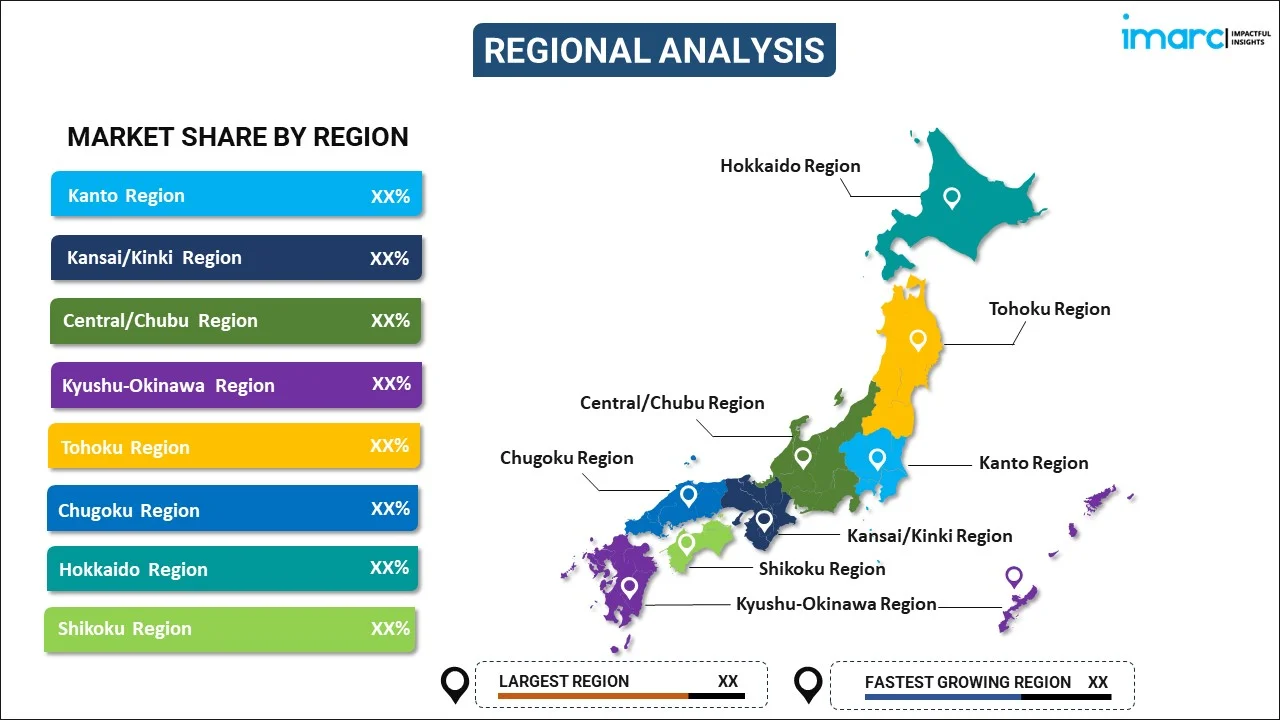
Japan Application Delivery Controller Market Report by Type (Hardware Based ADC, Software Based ADC), Component (Products, Services), Organization Size (Large Enterprises, Small and Medium-sized Enterprises (SMEs)), Vertical (BFSI, IT and Telecom, Government and Public Sector, Healthcare and Life Sciences, Manufacturing, Retail, Energy and Utilities, Media and Entertainment, and Others), and Region 2025-2033
Market Overview:
Japan application delivery controller market size reached USD 172.8 Million in 2024. Looking forward, IMARC Group expects the market to reach USD 412.5 Million by 2033, exhibiting a growth rate (CAGR) of 9.5% during 2025-2033. The escalating demand for enhanced application performance and quicker content delivery, the growing adoption of cloud-based solutions among consumers, and continuous technological advancements across the globe represent some of the key factors driving the market.
|
Report Attribute
|
Key Statistics
|
|---|---|
|
Base Year
|
2024
|
|
Forecast Years
|
2025-2033
|
|
Historical Years
|
2019-2024
|
|
Market Size in 2024
|
USD 172.8 Million |
|
Market Forecast in 2033
|
USD 412.5 Million |
| Market Growth Rate 2025-2033 | 9.5% |
An application delivery controller (ADC) is a network device that helps manage and optimize the distribution of web-based applications across different computing resources. It serves as a point of control in the network. They distribute incoming application traffic across multiple servers to enhance load balancing, ensure high availability, and increase the overall performance of applications. It comes in various types, including hardware-based solutions, software-based virtual appliances, and cloud-native ADC services. The primary aspects of ADCs cover load balancing, SSL offloading, and web application firewall capabilities. Load balancing efficiently distributes incoming application traffic across multiple servers, ensuring that no single server becomes a bottleneck, which enhances application performance. SSL offloading takes over the SSL decryption tasks from the web servers, freeing them to focus on serving the application logic. Additionally, some ADCs provide web application firewall functionalities to protect against web application vulnerabilities. The advantages of deploying an application delivery controller include improved application availability by directing traffic away from servers that are down or overloaded, flexibility and scalability, and easy integration with cloud infrastructure and services.
Japan Application Delivery Controller Market Trends:
The market in Japan is majorly driven by the increasing demand for enhanced application performance and quicker content delivery among Japanese enterprises. As businesses continue to embrace digital transformation, the need for effective load balancing and application scalability has become paramount. This is particularly relevant in sectors such as e-commerce, finance, and healthcare, where high availability and low latency are crucial for user experience and business continuity. Another significant driver is the growing adoption of cloud-based solutions in Japan. As companies transition to cloud infrastructure, the need for cloud-native ADC services that offer flexibility, scalability, and ease of management is on the rise. This is propelling the adoption of software-based and cloud-native ADCs over traditional hardware-based solutions, a shift that aligns with Japan’s focus on innovation and technological advancement. In addition, cybersecurity concerns are playing a pivotal role in market growth. With cyber threats, including Distributed Denial of Service (DDoS) attacks, becoming increasingly prevalent, the role of ADCs in providing robust security features such as Web Application Firewalls (WAF) and SSL offloading is becoming more critical. Moreover, the awareness of the importance of application availability and performance optimization in enterprise settings is also contributing to market expansion. Apart from this, companies are now more aware of the fact that application downtime can lead to significant financial losses and damage to brand reputation, further impacting the market. Furthermore, rising eco-consciousness is emerging as a trend as major companies are adopting sustainable technology solutions. This aligns with the global movement towards sustainability and resonates well with Japan’s commitment to environmental conservation, thereby creating a positive market outlook.
Japan Application Delivery Controller Market Segmentation:
IMARC Group provides an analysis of the key trends in each segment of the market, along with forecasts at the country level for 2025-2033. Our report has categorized the market based on type, component, organization size, and vertical.
Type Insights:

- Hardware Based ADC
- Software Based ADC
The report has provided a detailed breakup and analysis of the market based on the type. This includes hardware based ADC and software based ADC.
Component Insights:
- Products
- Services
A detailed breakup and analysis of the market based on the component have also been provided in the report. This includes products and services.
Organization Size Insights:
- Large Enterprises
- Small and Medium-sized Enterprises (SMEs)
The report has provided a detailed breakup and analysis of the market based on the organization size. This includes large enterprises and small and medium-sized enterprises (SMEs).
Vertical Insights:
- BFSI
- IT and Telecom
- Government and Public Sector
- Healthcare and Life Sciences
- Manufacturing
- Retail
- Energy and Utilities
- Media and Entertainment
- Others
A detailed breakup and analysis of the market based on the vertical have also been provided in the report. This includes BFSI, IT and telecom, government and public sector, healthcare and life sciences, manufacturing, retail, energy and utilities, media and entertainment, and others.
Regional Insights:

- Kanto Region
- Kansai/Kinki Region
- Central/ Chubu Region
- Kyushu-Okinawa Region
- Tohoku Region
- Chugoku Region
- Hokkaido Region
- Shikoku Region
The report has also provided a comprehensive analysis of all the major regional markets, which include Kanto Region, Kansai/Kinki Region, Central/ Chubu Region, Kyushu-Okinawa Region, Tohoku Region, Chugoku Region, Hokkaido Region, and Shikoku Region.
Competitive Landscape:
The market research report has also provided a comprehensive analysis of the competitive landscape. Competitive analysis such as market structure, key player positioning, top winning strategies, competitive dashboard, and company evaluation quadrant has been covered in the report. Also, detailed profiles of all major companies have been provided.
Japan Application Delivery Controller Market Report Coverage:
| Report Features | Details |
|---|---|
| Base Year of the Analysis | 2024 |
| Historical Period | 2019-2024 |
| Forecast Period | 2025-2033 |
| Units | Million USD |
| Scope of the Report | Exploration of Historical and Forecast Trends, Industry Catalysts and Challenges, Segment-Wise Historical and Predictive Market Assessment:
|
| Types Covered | Hardware Based ADC, Software Based ADC |
| Components Covered | Products, Services |
| Organization Sizes Covered | Large Enterprises, Small and Medium-sized Enterprises (SMEs) |
| Verticals Covered | BFSI, IT and Telecom, Government and Public Sector, Healthcare and Life Sciences, Manufacturing, Retail, Energy and Utilities, Media and Entertainment, Others |
| Regions Covered | Kanto Region, Kansai/Kinki Region, Central/ Chubu Region, Kyushu-Okinawa Region, Tohoku Region, Chugoku Region, Hokkaido Region, Shikoku Region |
| Customization Scope | 10% Free Customization |
| Post-Sale Analyst Support | 10-12 Weeks |
| Delivery Format | PDF and Excel through Email (We can also provide the editable version of the report in PPT/Word format on special request) |
Key Questions Answered in This Report:
- How has the Japan application delivery controller market performed so far and how will it perform in the coming years?
- What has been the impact of COVID-19 on the Japan application delivery controller market?
- What is the breakup of the Japan application delivery controller market on the basis of type?
- What is the breakup of the Japan application delivery controller market on the basis of component?
- What is the breakup of the Japan application delivery controller market on the basis of organization size?
- What is the breakup of the Japan application delivery controller market on the basis of vertical?
- What are the various stages in the value chain of the Japan application delivery controller market?
- What are the key driving factors and challenges in the Japan application delivery controller?
- What is the structure of the Japan application delivery controller market and who are the key players?
- What is the degree of competition in the Japan application delivery controller market?
Key Benefits for Stakeholders:
- IMARC’s industry report offers a comprehensive quantitative analysis of various market segments, historical and current market trends, market forecasts, and dynamics of the Japan application delivery controller market from 2019-2033.
- The research report provides the latest information on the market drivers, challenges, and opportunities in the Japan application delivery controller market.
- Porter's five forces analysis assist stakeholders in assessing the impact of new entrants, competitive rivalry, supplier power, buyer power, and the threat of substitution. It helps stakeholders to analyze the level of competition within the Japan application delivery controller industry and its attractiveness.
- Competitive landscape allows stakeholders to understand their competitive environment and provides an insight into the current positions of key players in the market.
Need more help?
- Speak to our experienced analysts for insights on the current market scenarios.
- Include additional segments and countries to customize the report as per your requirement.
- Gain an unparalleled competitive advantage in your domain by understanding how to utilize the report and positively impacting your operations and revenue.
- For further assistance, please connect with our analysts.
 Inquire Before Buying
Inquire Before Buying
 Speak to an Analyst
Speak to an Analyst
 Request Brochure
Request Brochure
 Request Customization
Request Customization




.webp)




.webp)












